Content Warning: This article will contain discussions of the Holocaust and the Third Reich.
Last week, promo material for Amma Asanta’s newest movie starring Amandla Stenberg and George McKay was released. It’s called Where Hands Touch and focuses on the story of a biracial German girl who falls in love with a white German boy during the time of the Third Reich. People were and are understandably concerned, so much so that both Asante and Stenberg released statements about it on their social media platforms.
The whole thing got me thinking about the depiction of Nazis in various films and franchises, most of which are pop-cultural cornerstones, and about the current political climate of growing authoritarinism and nationalism. How Nazis are portrayed in pop culture has always fascinated me, to be honest, and that might be because I’m German and was thus sort of surrounded by the knowledge and acknowledgment of what the Nazis did. Obviously, there isn’t just the depiction of outright WWII-era Nazis, but also a plethora of Nazi-inspired villains such as the Death Eaters. I feel like it’s necessary to talk about both of those and the problems I personally have with them.
Nazi inspired Villains and Nazi Allegories
Star Wars is one of those franchises whose villains where fairly clearly inspired by, at the very least, the aesthetics of the Nazis. It’s probably the most obvious in The Force Awakens when Hux gives his speech on Starkiller base before destroying the Republic, but it’s there in the previous movies as well—for example in the very name “stormtrooper.” It’s taken from the English translation of “Strumtruppen” which was the name of a specialist section of the Wehrmacht that fought mostly using infiltration tactics. However, inspiration for the Empire being drawn from the Nazis is maybe most obvious when looking at the uniforms of high ranking members of the Empire and how much those resemble the uniforms of the Nazi SS.
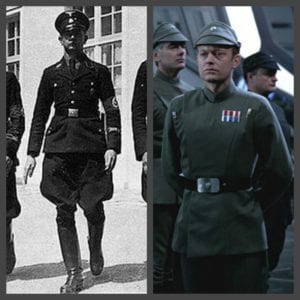
Another example of Nazi-inspired villains is unarguably Hydra, an organization that literally grew out of the Third Reich. Unfortunately, I am deeply ignorant when it comes to comics, so I’ll focus on Hydra in the Marvel Cinematic Universe instead. We’re first introduced to the organization as being the Nazi science division in Captain America: The First Avenger which goes rogue when its leader Red Skull/Schmitt does. Seemingly defeated by Captain America, Hydra reappears in Captain America: The Winter Soldier and the first season of Agents of S.H.I.E.L.D when it becomes clear that the organization wasn’t actually destroyed but went underground.
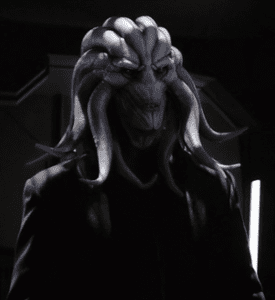
While the movies and roughly the first and a half season continue to make it clear that Hydra is in fact a Nazi organization, the third season did a complete 180 on that and retconned Hydra into not in fact having its roots in Nazi-era Germany. Instead, the organization is actually a sort-religious order trying to get its leader, the inhuman Hive, back from the planet he was banished to. Hydra merely infiltrated Nazi-Germany to work towards its own goals and then abandoned Nazi ideology again when it was no longer useful.
In both of these cases, the villains are either vaguely inspired by, or directly linked to the Nazis, but ideologically have very little in common with them. Both Hydra and the Empire simply aim to take over the world, establish themselves as their eternal rulers and squash all dissent.
But that’s not what the Nazis were and wanted: they were a white supremacist organization with a deeply nationalistic ideology that aimed to exterminate anyone who they saw as damaging the so called “Volkskörper”, the elementary racial body of Germans. The primary victim of this ideology were Jewish people, but Rromani, disabled, and gay people were also targeted.
This reality of Nazi ideology is far better mirrored in JK Rowling’s Harry Potter series. The Death Eaters do not simply aim to take over Wizarding Britain—their aim is to get rid of all those they deem impure and thus a threat to Wizarding society. Again, this mainly affects a certain group of people (Muggleborn witches and wizards) but others, especially those who openly sympathize or ally with them, are also persecuted. In my opinion, JKR gets a fundamental fact about the Nazis right in her depiction of the Death Eaters and British Wizarding society: hatred and condescension towards Muggleborns is not something that is shown as limited to the Death Eaters and their sympathizers, it’s something that is deeply entrenched in the entire society, much like antisemitism was in twenty-century Europe.
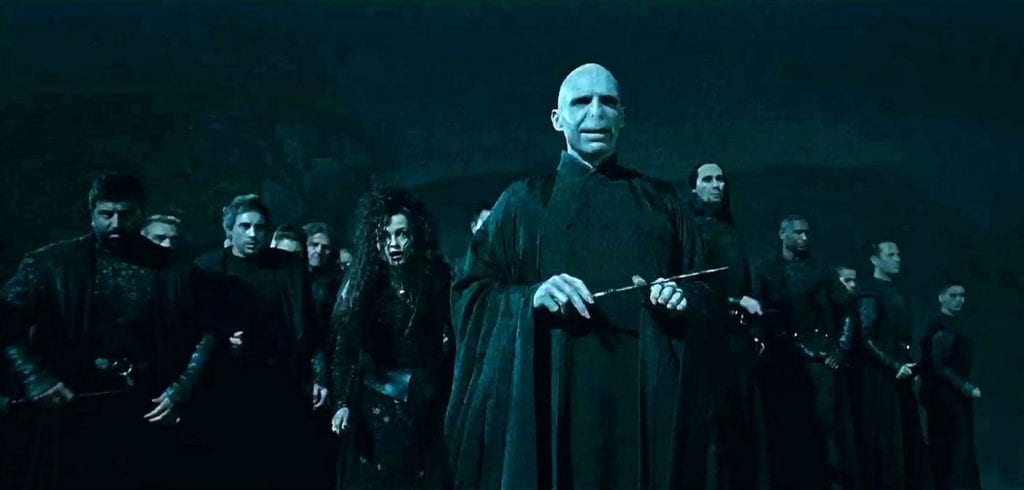
At the same time, I always struggled with the fact that groups like werewolves who were vilified as “dangerous half-breeds” and distrusted by large parts of regular Wizarding society were described as allying with Voldemort rather than being targeted by him as well. On the one hand, it makes perfect sense that members of a strongly marginalized group would turn to the first person they perceive as respecting them and promising them rights and equal opportunity. On the other hand, the core Death Eaters are recruited from old Pureblood families which probably hold the same prejudices against werewolves and giants as the less radically anti-Muggleborn rest of Wizarding society. If the mainstream of Wizarding society already sees these groups as a threat to their society, why wouldn’t the more radical Death Eaters do so as well and aim to exterminate them? Ultimately, JKR positions it as more likely that marginalized groups would be allied with Nazi-like forces than threatened by them.
Ultimately, this is the problem I have with fictional villains vaguely inspired by or based on Nazis: They can’t realistically portray what Nazi ideology is like. Some of them obviously don’t even aim to—Star War’s Empire being the most obvious example—but even the ones who do mess up in places. Of course, there’s the question whether fiction really needs to portray Nazis and their ideology realistically. After all, fiction is supposed to over a place to escape to from the sometimes bleak reality of our lives, isn’t it?
This is an issue I’m quite frankly torn about. Yes, escaping to a world of fiction where Nazis can easily get defeated by the hero of the week can feel incredibly fulfilling but at the same time, I firmly believe that how we represent issues in fiction forms how we think about them in real life. Stories matter, especially when it comes to learning about aspects of the world that we know little about. I can’t help but look at how Nazis and Nazi-inspired villains are portrayed as essentially simply power hungry maniacs who want to squash all dissenters and at how people argue that punching Neonazis makes you just as bad as them because you’re taking away their right to free speech, because that’s essentially all Nazis aim to do, and wonder if there isn’t a link.
Historical Nazis and the Third Reich
Which brings me to the second type of Nazis portrayed in media, namely actual WW-II era Nazis. Although I’m using an image of Indiana Jones for this article, I’ve unfortunately never seen any of the actual movies, so I’m going to talk about Inglorious Basterds and The Book Thief instead.
Inglorious Basterds is a fairly typical Quentin Tarrantino movie focusing on two attempts to assassinate Nazi-Germany’s leadership. The titular “Basterds” are a group of primarily American Jewish soldiers who murder and scalp Nazi soldiers, spreading fear among them. Both the Basterds and the Jewish woman Shosanna are working to murder the heads of the Nazi leadership during a film premiere in Shosanna’s cinema, but don’t know of each others plan. Despite being almost exposed by the Nazi Landa, who also murdered Shosanna’s entire family three years earlier, the plan succeeds and Hitler, Goebbels and everyone else present at the cinema die. Landa, however, has negotiated immunity for himself and is driven into Allied territory by the last surviving Basterd, who carves a Swastika into his forehead to make sure that he can’t hide his Nazi past. 
Although the movie’s topic is unarguably the fight against Nazis by Jews, antisemitism, one of the core features of Nazism, is sidelined: The German sniper Fredrick Zoller, one out of two Nazis featured in the film who does not essentially immediately die, is a patriotic yet comically self-important war hero whose unrequited infatuation with Shosanna essentially causes the downfall of the Third Reich. The other Nazi character, Hans Landa, nicknamed the “Jew Hunter”, is not even a convinced antisemite and white supremacist, but an opportunist who lets all of Nazi Germany die to ensure his own survival and immunity. As enjoyable as seeing Nazis suffer as punishment for being Nazis can be, they are again primarily portrayed as power-hungry madmen who need to be taken out for being power-hungry madmen rather than for being white supremacist antisemites who engineered the most horrible genocide of world history.
The Took Thief, my final example, is a book by Markus Zusak that was made into a movie in 2013. It follows the German girl Liesel Meminger who is sent to live with Hans and Rosa Huberman during the second World War. The Hubermans start to hide the Jewish Max Vandenburg because Liesel’s foster father owes a life debt Max’s father. However, when Hans gives bread to a Jewish man being marched to the concentration camp Dauchau by the SS, he draws attention to his family and sends Max away out of fear that he would be discovered and deported as well. When another procession of Jewish prisoners is marched through her hometown roughly a year later, Liesel recognizes Max in the crowd and tries to speak to him before being whipped as punishment for this by Nazi guards.
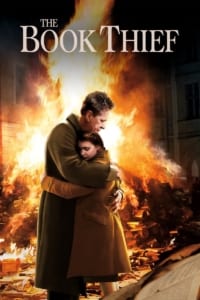 Although the book and movie take place during the Holocaust, they focus on the plight of the ordinary German. One could even argue that these ordinary Germans are portrayed as also being victims of Hitler and the Nazis because they, too, went through hardships under their rule.
Although the book and movie take place during the Holocaust, they focus on the plight of the ordinary German. One could even argue that these ordinary Germans are portrayed as also being victims of Hitler and the Nazis because they, too, went through hardships under their rule.
Again, the actual ideology of the Nazi regime is barely featured. In one scene, for example, Liesel declares that she hates Hitler, but not because of how he is persecuting and exterminating Jewish people and other minorities…because he is burning books. Although the suffering of Jewish people is addressed through the character of Max, it is decisively less important than the hardships of Liesel, her family and friends. The Nazis who are featured are just face- and nameless antagonists on the fringes who make the lives of the ordinary Germans just trying to go about their everyday lives hard. And not a single ordinary German actually agrees with what the Nazis are doing, they’re just all powerless to do anything against it.
Where Hands Touch and the Question of German Awareness
This is one of my biggest problems with the portrayal of Nazis and WWII-era Germany in fiction and it’s also why I am more than a bit on edge about Amma Asante’s movie Where Hands Touch. As mentioned already, the movie focuses on an Afro-German girl who falls in love with a member of the Hitler Youth in 1944. In response to criticism of the movie, Asanta posted on Instragram that her “wish has been to explore how black and bi-racial German identity was perceived and experienced under Nazi fascist rule”. This, in and of itself, is honestly the opposite of a problem. The plight of Afro-Germans in the Third Reich is something that I don’t think has ever been addressed in a pop-cultural context. Even in actual German history lessons, it’s something that remains firmly sidelined. So the general idea of the story of a biracial child in the Third Reich is actually something that immediately piques my interest. What discomforts me is another part of her statement:
“It looks at how Germany became Nazi Germany and slept walked itself into a disgusting and murderous state that resulted in it killing its own people and those of other countries.”
This is based on the idea that Germans did not actually know what they were doing, and that the Nazis and Hitler gaining power was an unfortunate accident that most ordinary Germans had nothing to do with. That’s simply not true. Germany did not “sleep walk itself into a disgusting and murderous state”—it elected the Nazis into government by giving 33% of votes to the NSDAP in the 1932 elections and 44% in 1933, in the last free elections in Germany until the 50’s. Historians argue that despite rigged elections and polls, there’s still more than enough evidence that Hitler was immensely popular among the Germans of the time, especially after the annexation of the Rhineland and Austria and the victory over France.
Of course, one could argue that the Germans did not truly know what they were signing up for by voting for him. But the program of the NSDAP, Hitler’s party, had remained unchanged since 1920 and proclaimed in point 3 already that only members of the German race were citizens, that only people of German blood could be members of the German race and that thus, no Jew could ever be a citizen of Germany. Only citizens—meaning only those of German blood—should be able to to have a political voice, be provided for by the German state, live within it and publish in or financially support the German press. The party program also proclaimed that all those whose activity was injurious to the general interest were to be punished with death and that the interests of the individual had to be disregarded in favor of the common interest of the state.
Even then, the persecution and industrialized mass murder of 6 million Jewish people as well as the murder of 5 million non-Jews that went on for roughly 12 years in all of Germany can’t have been something that a majority of Germans was actually aware and even supportive of, can it? Historical evidence points to the opposite, though. For one, Hitler had repeatedly declared his intent to exterminate all Jews as a way of protecting Germany from the essential threat they presented even before he came into political power. His book Mein Kampf laid out his plans for this in broad daylight for everyone to read. And, as the historian Robert Gellately details in his book Backing Hitler: Consent and Coercion in Nazi Germany, reports about the forerunners of the later concentration camps were widely published in German newspapers between 1933 and 1941. He states that
“In November, 1938 the anti-Jewish pogrom on and after “the night of broken glass” was reported countrywide in papers as heroic. The propaganda minister, Joseph Goebbels, announced that the “final answer” to the Jewish problem would be by way of government de cree, according to Volkische Beobachter.”
So no, Germans did not sleep walk into the Holocaust, and Assante proclaiming that they did is not just a historical falsehood, it’s a red flag.
Although she explains that the movie will not romanticize Nazis, the first promotional image does little to assuage such concerns. It shows George McKay in the uniform of the Hitler Youth holding hands with Amandla Stenberg’s character and leaning on her in the soft lighting of what looks like a living room.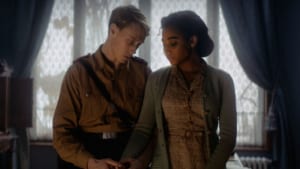 The fact that Stenberg dismisses all criticism of the movie expressed so far, many of which has been expressed by Black and Jewish people on social media, as people simply judging the movie out of a sense of self-righteousness and mob mentality, literally calling people sheep for expressing discomfort,only concerns me further.
The fact that Stenberg dismisses all criticism of the movie expressed so far, many of which has been expressed by Black and Jewish people on social media, as people simply judging the movie out of a sense of self-righteousness and mob mentality, literally calling people sheep for expressing discomfort,only concerns me further.
Of course, the movie isn’t in the cinemas yet. Not even a trailer has been released. It’s entirely possible that it handles the topic with great sensitivity, attention to detail and without unnecessarily downplaying the reality of antisemitism, hatred and violence that Nazi ideology entailed. The latter would be incredibly necessary in our current political climate—something that Assante’s statement makes clear she is aware of. But it’s also a possibility that Where Hands Touch makes the same mistakes as The Book Thief by portraying the majority of the German population as being absolutely unaware of the actual realities of what the Nazis were aiming to do. I’m really hoping it doesn’t.
At the same time, I think that we should have a broader conversation about the way Nazis have been and are still handled in popular fiction. It hasn’t been overly great. Nazi-inspired villains like the First Order who have little in common with the actual ideologies of Nazism and fascism abound, further push the widespread idea that Nazis are simply power-hungry and almost cartoonish rather than real threats to democracy, liberty and equality. Fiction that takes place in the Nazi era often does the same thing, as Inglorious Basterds does, but frequently also portrays the majority of Germans as not being on-board with the Nazi regime but being powerless to stop it.
It’s the latter that I find especially dangerous considering our political climate. The Nazis could not have risen to power if a majority of Germans had not supported them while another large part stood by silently. We can’t afford to not acknowledge this in our media.
Images courtesy of Warner Bros., Disney, and British Film Company

